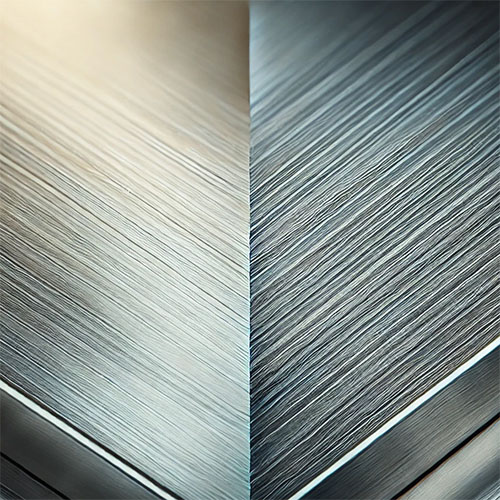When selecting materials for custom wire fabrication, stainless steel consistently ranks among the most reliable choices. Known for its exceptional durability, corrosion resistance, and ease of fabrication, stainless steel ensures high-quality results across various industries. However, not all stainless steel alloys are created equal. 304 vs 316 stainless steel – each possess distinct properties and applications. Understanding these differences is essential when deciding which alloy best suits your custom wire baskets, racks, and other wire fabrication projects.
At Salco Engineering, we’ve leveraged our extensive experience to help businesses choose the right stainless steel alloy for their specific needs. In this guide, we offer a clear comparison of 304 vs 316 stainless steel, highlighting their properties, strengths, limitations, and ideal applications in wire fabrication.
Understanding 304 Stainless Steel: Characteristics and Advantages
304 stainless steel is the most common alloy used in wire fabrication due to its excellent balance of affordability, strength, and versatility. Composed primarily of chromium (18%) and nickel (8%), it’s often referred to as “18/8 stainless steel.” This combination provides robust corrosion resistance suitable for many standard industrial and commercial applications.
The advantages of 304 stainless steel include:
- Cost-Effectiveness: Compared to other stainless steel alloys, 304 offers excellent durability at a lower cost, making it ideal for large-volume production and general-purpose applications.
- Ease of Fabrication: With its excellent formability and weldability, 304 stainless steel allows for efficient production processes and consistent quality in custom wire products.
- Good Corrosion Resistance: 304 stainless steel resists corrosion effectively in typical environments, including atmospheric moisture and most common chemicals.
- Strength and Durability: Suitable tensile strength and hardness ensure long-lasting performance in many wire fabrication applications.
Understanding 316 Stainless Steel: Characteristics and Advantages
316 stainless steel, while similar in many respects to 304, incorporates molybdenum into its alloy. This additional element significantly enhances its resistance to corrosion, particularly in harsh or corrosive environments. Specifically, 316 stainless steel is composed of approximately 16% chromium, 10% nickel, and 2-3% molybdenum.
Key advantages of 316 stainless steel include:
- Superior Corrosion Resistance: Due to its molybdenum content, 316 stainless steel provides increased resistance against chlorides, acids, and marine environments, substantially reducing the risk of corrosion-related damage.
- Enhanced Strength in High-Temperature Environments: 316 maintains excellent strength and durability even under high temperatures, making it ideal for demanding industrial applications.
- Extended Product Life: Its superior corrosion resistance often translates into extended service life, reducing maintenance costs and improving reliability.
- Sanitary Applications: Due to its hygienic properties and corrosion resistance, 316 stainless steel is the preferred choice for medical, food processing, and pharmaceutical environments.
Key Differences: 304 vs 316 Stainless Steel in Wire Fabrication
While both alloys are widely used, understanding their distinct differences can significantly influence the effectiveness of your wire fabrication projects. The key differences include:
- Corrosion Resistance: 316 stainless steel offers significantly better resistance to chloride-induced corrosion and acidic environments than 304.
- Cost: 304 stainless steel is generally more economical, making it an excellent choice for projects with standard corrosion resistance requirements. 316, while more expensive, provides greater reliability in extreme or corrosive conditions.
- Applications: 304 is ideal for indoor or non-aggressive environments, whereas 316 excels in outdoor, marine, chemical, and healthcare applications.
- Strength and Hardness: Both alloys have similar strength levels, though 316’s additional alloying elements provide slight improvements in tensile strength and resilience under extreme conditions.
Choosing Between 304 and 316 Stainless Steel for Custom Wire Fabrication
Determining the appropriate stainless steel alloy for your wire products involves considering several key factors:
- Environmental Conditions: Evaluate your wire products’ intended operating environment. If your products will face exposure to aggressive chemicals, saltwater, or acidic environments, 316 stainless steel is typically the wiser choice.
- Budget Constraints: For budget-sensitive projects with moderate corrosion exposure, 304 stainless steel delivers great value without compromising quality.
- Industry Requirements: Industries with stringent hygiene and safety standards, such as medical or food processing, typically require the enhanced properties of 316 stainless steel.
- Long-Term Maintenance Costs: 316 stainless steel can reduce maintenance costs due to its superior corrosion resistance, offsetting the initial investment over time.
Common Applications of 304 and 316 Stainless Steel Wire Products
Understanding typical industry uses can clarify your decision-making process:
Applications for 304 stainless steel wire products:
- Retail and product displays
- General-purpose industrial baskets and racks
- Food storage racks (dry environments)
- Commercial kitchen equipment
- Consumer goods and retail fixtures
Applications for 316 stainless steel wire products:
- Medical baskets and sterilization trays
- Marine and shipbuilding components
- Food processing equipment
- Pharmaceutical storage solutions
- Chemical processing equipment and fixtures
How Salco Engineering Supports Your Wire Fabrication Needs
At Salco Engineering, we specialize in designing and manufacturing custom wire baskets and racks using both 304 and 316 stainless steel. Our expert team collaborates closely with clients to ensure that their specific needs and environmental conditions guide the choice of material.
Our comprehensive services include:
- Custom product design and engineering
- Rapid prototyping and sample creation
- Precision manufacturing with strict quality control
- Consultation and guidance on material selection and design optimization
With decades of experience, Salco is committed to delivering stainless steel wire products that meet and exceed industry standards, providing you with reliable, high-quality solutions tailored precisely to your needs.
Conclusion: Selecting the Right Stainless Steel for Your Wire Products
304 vs 316 stainless steel for wire fabrication; which is the right choice? This is a critical decision that affects product performance, durability, and overall cost-effectiveness. By thoroughly understanding the environmental conditions, industry standards, and performance expectations, you’ll make informed decisions that optimize your investment.
If you’re uncertain which alloy is best suited to your project’s requirements, Salco Engineering’s experienced team is here to guide you through every step of the process. Contact us today to discuss your custom stainless steel wire fabrication needs and discover how we can provide solutions designed for lasting performance and reliability.



